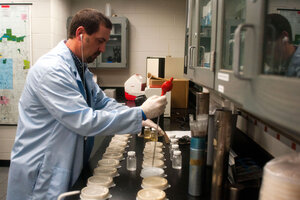Most Americans don't drink (or trust) tap water: Should they?
A poll suggests Americans are concerned about their water quality in the wake of the Flint, Mich., water crisis. How to check the quality of your city's water?

Michael Glasgow, laboratory water quality supervisor, tests water at the Flint, Mich., plant on July 22, 2013. The EPA said states should bolster confidence in public water systems by making information lead and copper testing results and the location of lead water pipes available online.
Jake May/The Flint Journal/AP/File
Peggy Schwartz has lived in Phoenix for 54 years, where she drinks bottled water to avoid what she describes as the bad-tasting tap water.
"I use, for drinking, all bottled water and have forever," says Ms. Schwartz, a realtor, in a phone interview. "But I've never had anything tested. I don't know statistically if it's good, bad, or what."
Schwartz is not alone in wondering about her water quality. More than half of Americans worry that Flint's water crisis is a bellwether for bad water, according to a poll by the Associated Press/GfK, and only one in three is willing to drink water straight from the tap.
All cities are required to provide quality reports to water consumers, but few cities have followed Boston's example in mapping the location of lead pipes.
Before 1950, most pipes carrying water from the main lines to homes and businesses were made of lead, rather than copper, and cities do not always know which have been replaced, reported John Wisely and Todd Spangler for the Detroit Free Press.
"This is nuts," said Dr. Jeffrey Griffiths, public health professor at Tufts University and a former chairman with the US Environmental Protection Agency's Drinking Water Committee. “Given what we know about lead, we need a national mapping in my view of what’s out there.... We just have giant holes when it comes to our understanding of how much lead is in the ground.”
Water quality, like many public services, is often worst in low-income neighborhoods, and the AP/GfK poll suggests Americans are generally aware of this. In households with an income above $100,000, 6 in 10 people were comfortable with their water quality, but only 4 in 10 from households making less than $50,000 were. The poll also indicated a racial split, with only 28 percent of Hispanics, compared to 40 percent of blacks and 54 percent of non-Hispanic whites, expressing confidence in their tap water.
In 2003, the National Resources Defense Council ranked the municipal water in 19 US cities and identified three requirements for good water: a protected water source – stream, lake, well, or reservoir – as well as sound pipes and a modern water treatment facility.
It's harder to quantify what makes water taste good to drinkers. Every summer, the American Water Works Association holds a tap water taste test. In 2015, top honors went to Big Sky, Mont., while the 2014 award for tastiest tap water went to Boston, which has some of the oldest pipes in the country.
Some cities with older plumbing use corrosion control treatments to purify water that passes through lead pipes; the city of Flint had neglected this step for three years. Without treatment, lead leaches into the water and, over time, can poison those who drink it.
"There’s a huge problem with political will," Professor Griffiths told the Detroit Free Press. "If Al Qaeda decided to poison our children, we’d be all over it... Instead, we have neglected our own infrastructure. It boggles the mind."

